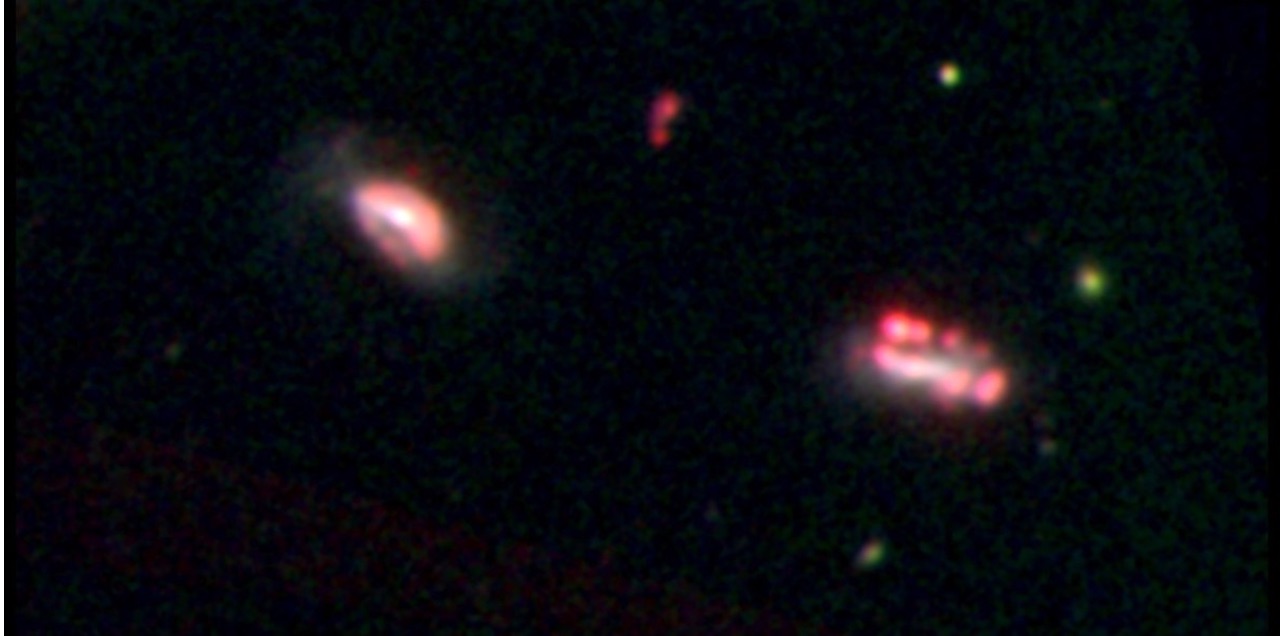Astronomy - Elusive Dwarf Galaxies Found Hidden Away in Tiny Clusters

An optical observation of one of the isolated galaxy groups observed with the Magellan Telescope in Chile. The red knots reveal emissions that signify recent and ongoing star formation. The deep optical image also reveals asymmetrical morphologies/shapes possibly resulting from an interaction.
Credit: Kelsey E. Johnson, Sandra E. Liss and Sabrina Stierwalt
Computer simulations and theoretical models have shown that clusters of miniature galaxies, some 10- to 1,000 times smaller than the Milky Way, should exist, but proof has been elusive. Detections of dwarf galaxy clusters would provide key evidence that the current theory for how the universe evolved structures is correct.
The so-called Lambda Cold Dark Matter paradigm is the prediction that smaller things merge to form bigger things, University of Virginia astronomer Sabrina Stierwalt told Seeker. But there has been scant observational evidence of this process for low-mass galaxies despite the fact that small galaxies greatly outnumber bigger ones like the Milky Way, she added.
In paper published in this week's Nature Astronomy, Stierwalt and colleagues describe a new hunt for dwarf galaxy clusters using data from the Sloan Digital Sky Survey.
The team first looked for pairs of interacting dwarf galaxies, then studied those pairs to see if they could be part of a bigger group.
Follow-up observations with the Magellan Telescope in Chile, the Apache Point Observatory in New Mexico and the Gemini North Telescope in Hawaii provided optical images and spectroscopy of additional suspected group members.
In all, the scientists found seven groups of dwarf galaxies, each with three- to five members.
"We suspect these groups are gravitationally bound and thus will eventually merge to form one larger, intermediate-mass galaxy," Stierwalt said.
The galaxies are located between 200 million and 650 million light-years from Earth.
"That sounds like a lot but it is relatively nearby given the vast size of the universe. Dwarf galaxies are fainter and smaller than more massive galaxies like the Milky Way we reside in, and so they are harder to detect at farther distances," Stierwalt said.
The number of clusters matches predictions, which builds confidence in the computer models.
"Such groups are predicted to be rare theoretically and found to be rare observationally at the current epoch," the astronomers noted in the paper.
The newly found dwarf galaxy groups "provide direct probes of hierarchical structure formation in action at the low mass end, giving us a new window into a process expected to be common at earlier times, but nearly impossible to observe at such redshifts," the paper said.
"Redshifts" is a cosmic yardstick for measuring distance and time. It refers to the lengthening of wavelengths of light as a radiating object moves farther away, similar to how the sound of a train shifts as it recedes.
1 comment:
Thanks For Sharing Very Useful Information With Us Admin Keep It Up Taj Mahal Tiger Tourism
Post a Comment